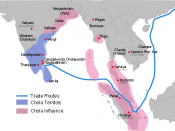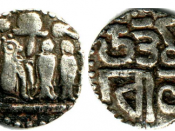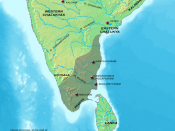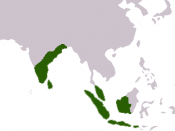Q1. Write a note on the village administration ( village assemblies) of the Cholas during the Early Medieval period.
A. The Chola kings followed a highly efficient system of' administration. The entire Tanjore district, parts of'Trichy, Pudukottai and South Arcot districts formed the part of' the Chola Mandalam. The Cholas had three major administrative divisions called Central Government, Provincial Government and Local Government. Tanjore was the capital of the Cholas. The efficient Chola administrative system has been well appreciated by many historians and rulers.
Central Government: The Central Government t under the headship of the King. Council of ministers and officials took active part in running the administration of Central Government. The higher officials were called Peruntaram and the lower officials were called Siruntaram.
Provincial administration: The Chola Empire was divided into nine provinces. They were also called mandalams. The head of the province was called viceroy. Close relatives of kings were appointed as viceroys.
The Viceroys were in constant touch with the Central Government. Viceroys received orders from the king. They sent regular reply to the king. The viceroys had a large number of officials to assist them in the work of administration.
Administrative Divisions: The success of the Chola administration depended more on the proper functioning of the administrative division us. Generally mandalams were named after the original names or the titles of the Chola kings. Each mandalam was divided into number of Kottams or Valanadus. Each kottam was sub divided into nadu. Each nadu was further divided into (Urs) villages which form part of the last unit of the administration. Uttaramerur inscriptions speak about the administration of the Cholas.
Justice: The Chola king was the chief justice. The Chola kings gave enough care for the judicial administration. The village level judicial administration was carried on by the village assembly. Minor disputes were heard by the village assembly. Disputes were settled with proper evidences. Punishments were awarded by the judicial officers. The trial of serious offences and major cases were conducted by the king himself.
Q2. Write an account of the Kautilya's contribution to the development of the Judicial System in Ancient India.
Kautilya's Arthashastra and Manu's Code of Law have been considered as the mostimportant treatises on the civil and criminal laws in ancient India. Several prominent Indologistshave evaluated the original contributions of these treatises. They find that The Arthashastra wasone of the primary sources of Manu's Code of Law.1 Also, it seems that Manu's sole objective inwriting the codes was to reestablish the social hierarchy, which was in many ways oppressive.2Whereas Kautilya wanted to build a prosperous, secure, safe, secular and fairness-based empire.3He considered both ethical and economic perspectives on creating laws. His proposal on tort lawcontained many noteworthy elements. First, he introduced monetary fines to complement theexisting expiation measures for preventing losses caused due to negligence. Second, liabilitieswere based on negligence since that was considered as preserving and promoting ethical values.
Third, deterrence being the primary goal, tort law was designed to minimize the probability of aloss caused by negligence or intention. That is, wealth maximization was the overriding concern.
Fourth, punitive damages particularly if intent was involved were large and all the receipts wentto the Treasury. Fifth, in addition to the punitive damages, the injurer was required to compensatethe victim for serious physical injuries and for all financial losses and government wasresponsible for taking care of the disabled individuals out of the general revenue. It appears that,to some extent, corrective justice was a part of distributive justice.
Pre-Kautilyan writers had primarily elaborated on expiation methods for freeing the defendant from his sins and were intended to enhance deterrence by modifying his behavior. Kautilya's objective was to complement the expiation methods with the introduction of the secular law. His implicit analysis is made explicit in section II. Kautilya's approach regarding torts was essentially to minimize the probability of accidents, and if they still happened, the state was to collect high fines from the injurers to supplement the general revenue of the government.
BIBLIOGRAPHY1. Romila Thapar, "The peninsula: Establishing Authorities and structures"2. Sreenivasa Murthy: "History of India for Law Students"3. S.C. Raychoudhury: "Social Cultural and Economic History of India"





